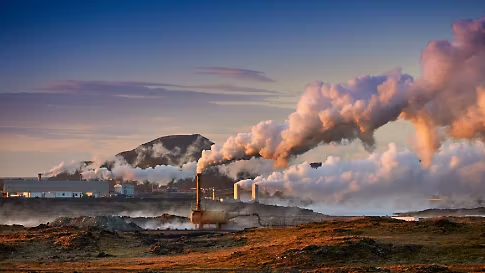Geothermal energy continues to garner headlines for technological advancement and new projects funded by investors, municipalities, business, homeowners and more. Geothermal energy is poised to garner more market share in the fast-growing clean energy space. Climate tech and sustainability public relations firm FischTank PR tasked its wonderful intern team with compiling a news roundup:
Microsoft and G42 Set to Build Data Center in Kenya Utilizing Geothermal Energy – Renewable Energy Magazine
As part of the agreement, G42, in collaboration with local partners, will design and build a state-of-the-art data center campus in Olkaria, Kenya, run entirely on renewable geothermal energy and designed with state-of-the-art water conservation technology. The data center will run on and provide access to Microsoft Azure through a new East Africa Cloud Region, which will become operational within 24 months of the signing of the definitive agreements.
This cloud region will provide customers access to scalable, secure, high-speed cloud and AI services to accelerate cloud adoption and the digital transformation of businesses, customers and partners across Kenya and East Africa.
President, Dr. William Samoei Ruto, stated that, “This partnership is bigger than technology itself. It is about coming together of three countries with a common vision of a nation empowered by technology, where every citizen has the opportunity to thrive in the global digital landscape. It’s about building a future where Kenya flourishes as a digital leader.”
A first-of-its-kind geothermal system will cool and heat dozens of homes in Massachusetts – ABC News
What Eversource has demonstrated with its pilot is that buildings don’t need to be transitioned one at a time and that whole neighborhoods can be eliminated from fossil fuels at once, Camargo said.
Thermal energy networks are the most efficient method in existence to heat and cool buildings, Camargo said. Instead of gas, water is carried through the pipes buried beneath the earth, and furnaces inside buildings are replaced with ground source heat pumps connected to water loops — a system that works akin to a conveyor belt transferring energy from inside to out or from outside to in.
“The reason why it’s so efficient is because we’re transferring energy,” Camargo said. “We are not creating new energy. We’re just literally transferring it.”
U.S. Department of Energy Announces $7 Million to Help Geothermal Energy Support a Decarbonized Electricity Grid – Department of Energy
Geothermal energy has the potential to provide firm, flexible, renewable power to over 65 million homes across the United States. The GTO GRID FOA focuses on creating new valuation metrics that capture geothermal power’s broader economic and reliability benefits, alongside research on supporting an equitable transition through geothermal deployment. Additionally, it includes the development of visual tools to clearly communicate research findings.
GTO intends to fund regional grid modeling studies within specific power pools, joint utilities groups, utility service territories, or Tribal jurisdictions in the conterminous United States, Alaska, Hawai’i, or U.S. territories. Through this funding opportunity, GTO aims to quantify the role of geothermal power in an equitable, decarbonized grid. This work will address the challenge of grid stability through detailed studies on how geothermal power can support and stabilize the grid as it incorporates higher shares of variable renewable energy sources.
Geothermal model gives key insights into extracting renewable energy from superhot, super deep rock – Eurek Alert
Geothermal energy from the superhot rock miles below our feet has the potential to become a major player in the energy transition, but first we need to develop ways to not only access those rocks, but also extract their heat. Now a computer model sheds light on the latter, describing for the first time what happens when rock at those depths and temperatures is exposed to fluids that can eventually transfer the rocks’ heat to the surface.
Essentially the model shows the formation of microscopic cracks creating a dense “cloud of permeability” throughout the affected rock. This is in contrast to the much larger and fewer macroscopic fractures induced by the engineered geothermal systems (EGS) in use today, which operate closer to the surface and at much lower temperatures.
Simulations using the model, which was reported in a recent issue of the journal Geothermal Energy, “confirm that a superhot system can deliver five to ten times more power than typically produced today from EGS systems for up to two decades,” says Trenton Cladouhos, Vice President of Geothermal Resource Development at Quaise Energy, which funded the work.
Google to power Nevada data center with 115 MW of geothermal energy – Power Engineering
Google has entered into an agreement with Berkshire Hathaway electric utility NV Energy to power its Nevada data centers with about 115 MW of geothermal energy.
Google says the proposed partnership has been sent to the Public Utilities Commission of Nevada for approval. The company has set a goal of powering its data centers and buildings with 100% carbon-free energy by 2030. In an environmental report released last year, Google said it has achieved 64% carbon-free energy at its data centers, and 56% at its offices.
The supply agreement for 115 MW of geothermal energy would increase the amount of enhanced geothermal capacity Google uses for operations by 25 times, according to the company.
New map shows vast potential for geothermal energy beneath entire US – The Hill
The purpose of GeoMap, Nelson said, is to “educate policymakers and the public about the potential for geothermal in any given jurisdiction — but more importantly, to then put it in the hands of people who are actually going to be building projects.”
“There’s huge parts of Texas and the Gulf Coast that have far more potential than previously thought,” Nelson told The Hill. “Parts of South Carolina and into West Virginia, Pennsylvania and New York are some interesting hot spots.” That, he said, “I think is one of the primary headlines: that oh my god, we can do geothermal [at] a lot more places than we previously thought.”
Colorado’s governor goes deep on geothermal energy grants to boost private renewables market – The Colorado Sun
Colorado launched a new era of investment in geothermal energy Friday in a two-pronged effort to broaden renewable sources and lower consumer bills, with Gov. Jared Polis going deep into the details of a $7.7 million round of grants meant to boost private developers.
“Energy is a cost that everybody is frustrated with,” Polis said in an interview Wednesday. “It’s really critical and essential that we look for creative ways to provide relief to people on their monthly bills. Imagine having zero heating and cooling bills on those warm summer days and cold winter days. That can save a family a lot of money with simply the upfront improvements that are put in before they even move in.”
How a nuclear bill became this Congress’ first big energy win – E&E News
In what has become an exceedingly rare phenomenon, lawmakers on Capitol Hill this week reached across the aisle and coalesced around a piece of energy legislation to send it to President Joe Biden’s desk. The support was resounding. The sweeping nuclear energy bill known as the “ADVANCE Act” sailed through the Senate as part of S. 870, the “Fire Grants and Safety Act,” on an 88-2 vote Tuesday, just over a month after the package garnered more than 390 votes in the House.
“I never talk about the importance of addressing climate change without talking about how we can address climate change in constructive ways and create a lot of jobs. We can do both,” he said. “Good jobs and a safer planet.”
EU wind and solar growth displaces fossil fuel generation, report says – Reuters
Wind and solar power generation in the European Union increased by 46% from 2019, when the current European Commission took office, to 2023, displacing a fifth of the bloc’s fossil fuel generation, a report by think tank Ember showed.
“The EU now has more home grown wind and solar than ever, pushing both coal and gas electricity generation down to historic lows,” said Sarah Brown, Europe programme director at Ember. “The EU is now in the midst of a historic, permanent shift away from reliance on fossil fuels for power.”
St. Paul schools turn towards geothermal energy as Minnesota‘s climate shifts – MPR News
A high school on the east side of Saint Paul is wrapping up its first year with a new heating and cooling system that draws energy from the ground. And the district plans to install more of these geothermal systems at two other schools as part of its goal of cutting greenhouse gas pollution. It’s joining a larger wave of investments in geothermal, as Sahan Journal Climate and Environment Reporter Andrew Hazzard writes in a recent story.
So the cost to implementing a geothermal system is high. So at Johnson, they paid over $18 million for this system. But right now, there are opportunities, through the federal Inflation Reduction Act, for school districts to get a 30% tax credit on this, which means that they can write off 30% of the cost of these projects. And the thing about these projects is that when you’re becoming much more energy efficient, you are lowering the amount of money that you are spending on your energy bills, on your utility bills, right? And so the savings will come over time. And if you add that to these tax credits that are available right now, that accelerates the process, the timeline for which this can be a huge financial win. So at Johnson, they estimate that over 30 years, this system will save them $7 million.
Brooklyn, New York geothermal project wins Plastics Pipe Institute award – Think Geo Energy
The 1 Java Street project in Brooklyn, New York was selected as the Building and Construction Division Project of the Year of the Plastics Pipe Institute, Inc. (PPI) at its 2023 awards event. A distinct characteristic of the project is that it will be the largest mixed-use development in New York State to incorporate a geothermal system for heating and cooling when it is completed in 2025.
The geothermal system of the project will have 321 vertical boreholes drilled 499 feet into the ground. These will be spaced 15 feet apart with a 1.25 inch high-density polyethylene (HDPE) PE4710 pipe inserted into each. A total of 326,000 feet of plastic pipes were used in the boreholes with another 31,000 feet in various diameters used for lateral distribution.
Do you have a geothermal energy project or technology that requires media exposure?
FischTank PR is the top sustainability and climate tech PR firm spanning renewables (solar, storage, geothermal, wind), battery chemistry, alternative fuels, grid edge technology, reporting software and other SaaS platforms, materials science, agtech and much more. If you’re interested in discussing a media relations and PR program for your brand, contact [email protected].
***Geothermal energy news roundup guest post from FischTank PR interns Baylee Matthews and Uju Ike***




